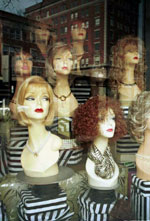

Often, all too often, the notion that is coupled with beauty is ‘symmetry’.
In order to prove this point photographs of movie stars and models are often published; but that provokes rather than answers questions.
Do such faces really represent beauty?
The chosen pictures do show a certain symmetry, but are they the only pictures of the only beauties available?
When we judge beauty, is symmetry actually a factor in our minds?
Is symmetry a factor in our judging of art, landscapes, and architecture?
Why do we prefer symmetry?
Do we need perfect symmetry, or is not a slight variation even more beautiful?
It has been suggested that symmetry in animals and human has been shown to be advantageous in terms of evolution. Walking, running and other movements would appear to be more efficiently done if the legs are not of different lengths; the more symmetrical creatures are better equipped to escape, hunt, and do a vast number of other things necessary for survival. Asymmetries may have been a sign of unhealthiness or mutation. Symmetrical creatures might therefore wish always to mate with other symmetrical beings, and that might have developed into a prerequisite for attractiveness.
A human face is called 'bilaterally
symmetrical' which means it contains mirror symmetry. Butterflies possess
such symmetry, and most have it, not merely in their faces, but throughout
their bodies. There is symmetry in architecture, in the design of artefacts,
of clothes, and furniture. Fruits and vegetables, too, appear, in the
main, to be symmetrical.
Those published theories which seem to suggest that bilateral symmetry
is an outward indicator of genetic health, and one which appeals to every
creature’s instinct for self-preservation do fail to admit with sufficient
emphasis that in many cases the symmetry is almost lirerally skin deep.
Yes, we do have two eyes, two ears, two arms, and two legs, and they tend
to be placed about each person in a balanced way; features like noses
and mouths achieve a balance but are placed in the middle.
It doesn’t work like that inside, though. You’ll have a heart over here, a liver there, and other bits and bobs any old where. There are some cases in which the positioning inside is reversed. And there have been cases of relationships ending when a partner found out about this, as if such irregularity were ugly.
But the powerful fact about this is that it shows that, skin deep as beauty may be, the world is full of thin-skinned people. One report suggested that it is lack of symmetry that turns people with eye-patches, wooden legs or peculiarly-formed backs into villains.
Apparently female barn-swallows tend to prefer males whose paired tail-forks are of similar lengths. In 1994, Nature published a paper entitled: 'Symmetry, beauty and evolution'. In that publication Magnus Enquist of the University of Stockholm, Sweden, and Anthony Arak, who does much of his research in Britain, put forward the notion that symmetrical objects are simpler to recognize from a variety of viewing angles than asymmetrical ones. Our vision-driven brains have learned to recognize symmetry as something special, and this may have been exploited in our choice of sexual partner as well as in our taste as regards the things we make.
Richard Jefferies, a palaeontologist of the Natural History Museum in London, has suggested that the tightly-regulated asymmetry of vertebrates all started as a symmetry-shattering accident. A symmetrical creature living on a long-vanished ocean floor was affected by this, perhaps more than 600 million years ago. That poor, benighted being was the ancestor of the vertebrates and since then vertebrates have been striving to regain that symmetry, a struggle that has been successful on the outside, but not internally.
Charles Darwin wrote this in 1872 in "The Descent of Man": "It is certainly not true that there is in the mind of man any universal standard of beauty with respect to the human body". He went on to say, " It is however, possible that certain tastes may in the course of time become inherited, though I know of no evidence in favour of this belief" Darwin had asked missionaries and ethnographers to describe the beauty standards of different ethnic groups. What he was told, and the range of answers, made it difficult to devise rules.
Plainly, though, beauty standards are culturally determined.
Even more than 100 years later the situation has not changed. Sarah Grogan is one of many people who have shown how beauty standards vary highly over time and history and between (and even within) societies. Evolutionary psychologists have failed to demonstrate convincingly that preferences for particular body shapes are biologically based.
Education is an important factor. In South Africa for example, throughout the Apartheid years, white schoolchildren were shown in a number of different classes from Art to ‘Race Studies’ that it was impossible for a black person to be beautiful. The campaign was only partially successful. In many cases pupils disagreed, and the forbidden fruit aspect of the lessons actively made sex between the races a more exciting prospect.
Recently there has been a very hot debate about sport. Men who are champions in their respective sports are often regarded as irresistible; maybe that has to do with the hope that a winner will produce good genes. What is baffling though, is that there are some women who play sport at a high level, but it is still the beautiful ones who get the attention. In a funny way the winners are often not regarded as attractive. They may be less than feminine in the eyes of male spectators, or too much of a threat, no-one is sure as yet. What is certain is that with many of these pretty types, when it comes to doing the job they are paid to do, they are crap. Seriously crap. This applies especially to tennis, and Anna Kournakova, for instance. No surprises there.

